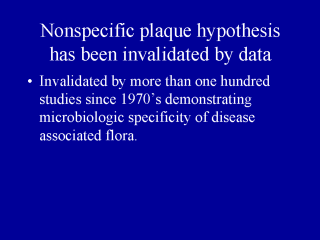|
|
|
|
front |1 |2 |3 |4 |5 |6 |7 |8 |9 |10 |11 |12 |13 |14 |15 |16 |17 |18 |19 |20 |21 |review |
 |
Millerís nonspecific plaque
hypothesis was first invalidated by studies which demonstrated qualitative
microbiologic species differences between health associated and disease
associated dental plaques in animal experimental models. With references from
studies conducted in the 1960ís and 1970ís, Loesche compiled a table of
three broad types of plaque associated with health caries and periodontitis. 8
Keyes, Rams also demonstrated bacterial profiles associated with health and
periodontal disease. They published these profiles in June 1983 in JADA in an
article entitled, "A rationale for management of periodontal diseases:
rapid identification of Ďtherapeutic targetsí with phase contrast
microscopy"
Loesche has reported in a recent literature review work 37 that there have been over one hundred studies in the last twenty five years comparing periodontal disease associated microflora with health associated microflora. Loesche has summarized the results of these studies and identified three bacterial species which are consistently associated with periodontal infections. Treponema denticola, Porphyromonas gingivalis and Bacterioides forsythus have been statistically associated with Early onset Periodontitis, , Adult Periodontitis and Refractory Periodontitis. These three types of periodontitis represent the vast majority of treatment cases in general practice today.34 This has resulted in his development of the BANA assay which uses enzyme hydrolysis technology to identify these three types of bacteria. Though this test does not differentiate between species, it may not be necessary since they are all sensitive to metronidazole as a systemic agent and locally(topically) delivered iodine as well as other irrigation agents. 35 |